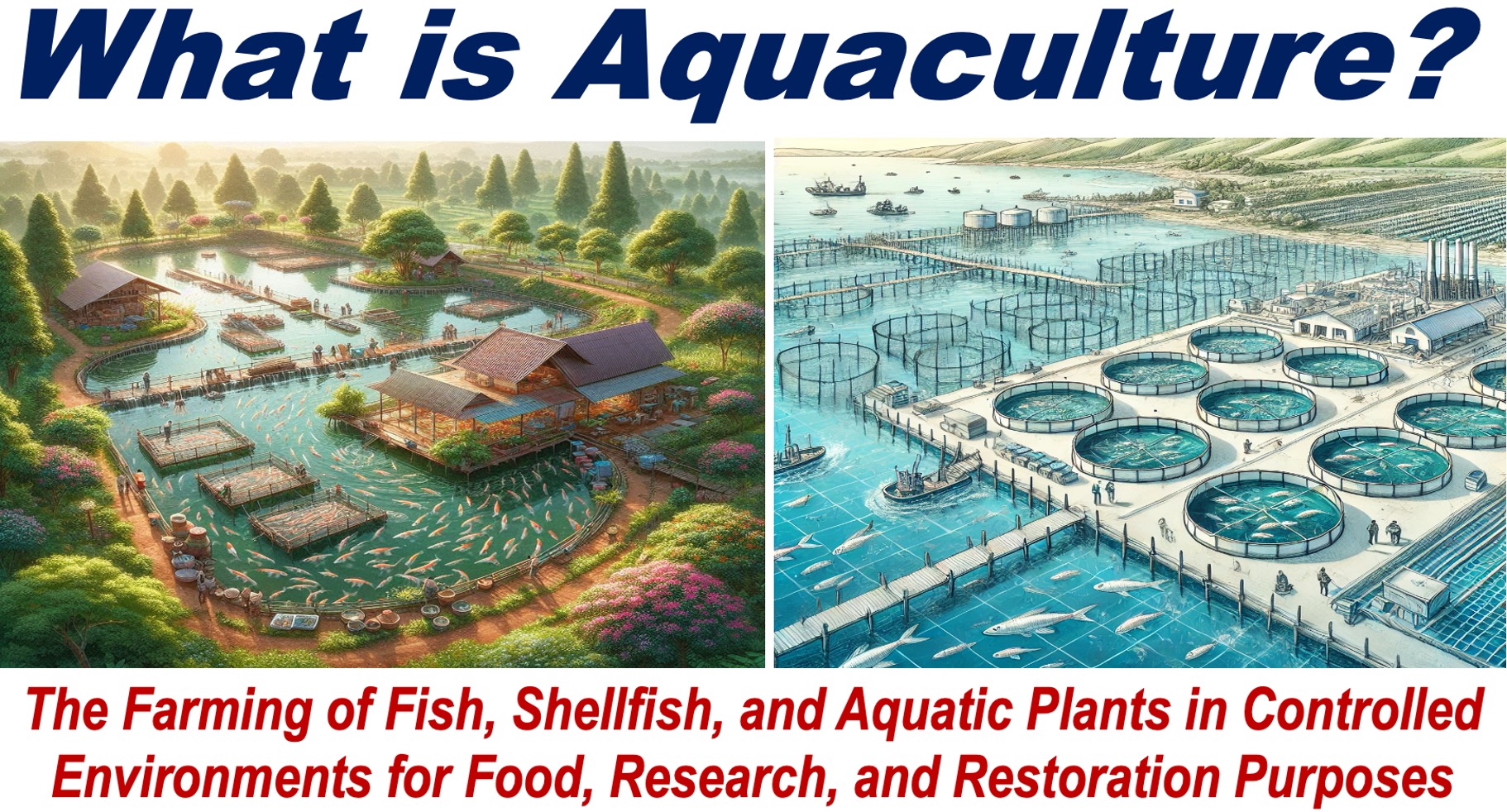Aquaculture, also known as aquafarming or fish farming, is the practice of breeding, raising, and harvesting aquatic organisms.
These organisms include fish, shellfish, seaweed, and other marine plants. Aquaculture is an important part of the global food industry and plays a key role in meeting the growing demand for seafood.
Etymology of Aquaculture
Etymology refers to where words came from and how their meanings evolved over time.
According to the Online Etymology Dictionary, the word “aquaculture” comes from two parts: “aqua,” meaning water, and “culture,” meaning cultivation.
It was first used in 1867 to describe the breeding of aquatic animals and the cultivation of aquatic plants for food.
The term has its roots in French, where it appeared around 1862. Another related term, “aquiculture,” specifically referred to fish breeding and was also recorded in 1867.
By 1888, “aquariculture” came into use to describe the management of aquariums and the plants within them.
Aquaculture – Food Security and Sustainability
The goal of aquaculture is to provide a controlled environment for aquatic species to grow.
This helps improve the quality and quantity of seafood available for consumption. It also reduces the pressure on wild fish populations, which are often overfished.
By farming seafood, we can meet your demand for fish and seafood in a sustainable way.

Freshwater & Marine
There are two main types of aquaculture: freshwater and marine.
Freshwater aquaculture involves raising species like tilapia, catfish, and trout in ponds, rivers, or other freshwater environments.
Marine aquaculture, on the other hand, takes place in the ocean or coastal areas and focuses on species like salmon, oysters, and seaweed.
Benefits of Aquaculture
One of the key benefits of aquaculture is that it can help protect natural ecosystems. In the wild, overfishing can cause serious damage to marine environments.
By farming fish instead of catching them from the wild, aquaculture helps ensure that wild fish populations stay healthy. This can have positive effects on the entire marine ecosystem.
Local Economies
Aquaculture also supports local economies. Fish farms create jobs in areas that rely on fishing for income.
Many small and medium-sized enterprises (SMEs) around the world benefit from aquaculture, whether they are directly involved in farming or in related industries like fish processing or distribution.
Challenges
However, aquaculture comes with its own challenges. For example, the waste produced by fish farms can pollute nearby waters if not properly managed.
In addition, some farmed species, such as salmon, require large amounts of feed, which can place pressure on other fish stocks.
To address these issues, many aquaculture businesses are focusing on sustainability by adopting practices such as improving waste management systems and using alternative feeds.
Reliable Seafood Supply
When done responsibly, aquaculture can be an effective way to provide a stable supply of seafood while minimizing environmental impact. As global demand for fish continues to rise, aquaculture will likely play an even larger role in how your seafood is produced. If you enjoy seafood, chances are that a portion of it already comes from an aquaculture farm.
Other Purposes of Aquaculture
When we hear the term ‘aquaculture,’ we think of fish or shellfish farming. However, there are many other purposes. Let’s take a brief look at ten of them:
- Stock Restoration: Rebuilding wild fish populations by breeding and releasing species back into their natural habitats.
- Baitfish Production: Raising fish to be used as bait for recreational or commercial fishing.
- Ornamental Fish Farming: Cultivating fish for aquariums and ponds, both for personal collections and commercial sales.
- Research and Education: Providing controlled environments for scientific studies on aquatic biology, breeding techniques, and species behavior.
- Aquatic Plant Cultivation: Growing plants like seaweed, algae, and other aquatic vegetation for use in food, cosmetics, pharmaceuticals, or biofuels.
- Biofiltration and Ecosystem Services: Using certain species to filter and clean water, reducing pollution, and helping maintain healthy aquatic ecosystems.
- Pharmaceuticals and Nutraceuticals: Cultivating marine organisms that produce compounds for use in medicines or health supplements.
- Feed for Livestock: Producing fish or aquatic plants that can be processed into feed for livestock or other farmed fish.
- Recreational Fishing: Raising fish species specifically for stocking in lakes, ponds, or rivers for sport fishing purposes.
- Energy Production: Using algae and other aquatic organisms to produce biofuels or energy-related materials.
In summary, aquaculture is a growing industry that provides seafood in a sustainable way.
By reducing the pressure on wild fish populations and supporting local economies, it offers a solution to the challenges facing both the fishing industry and our environment.
